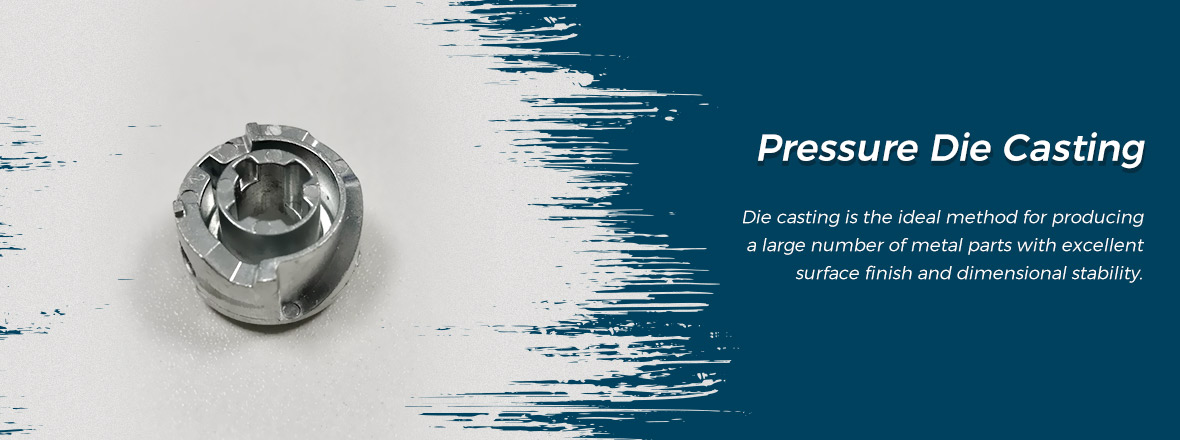Pressure Die Casting
Pressure die casting is a metal casting process. It is characterized by applying high pressure to the molten metal using the mold cavity. Molds are usually machined from stronger alloys, a process similar to injection molding. Most die castings are iron-free, such as zinc, copper, aluminum, magnesium, lead, tin, and lead-tin alloys and their alloys. Depending on the type of die casting, a cold chamber dies casting machine or a hot chamber die casting machine is required.

Pressure casting is a special casting method that has developed rapidly in modern metal processing technology with little or no cutting. It is the process of filling molten mold under high pressure and high speed and crystallizing and solidifying under high pressure to form castings. High pressure and high speed are the main features of pressure casting. The commonly used pressure is tens of MPa, the filling speed (in-gate speed) is about 16 to 80 m / s, and the time for filling the mold cavity with metal liquid is extremely short about 0.01 to 0.2 seconds.
Advantages of the pressure die casting
Die casting is the ideal method for producing a large number of metal parts with excellent surface finish and dimensional stability.
HPDC's production cycle includes:
1. Metering of metal into the shot sleeve.
2. Plunger movement.
3. Rapid die filling. The steel dies, typically 200-300°C, dissipates the latent heat.
4. During solidification, the casting is pressurized hydraulically by the plunger to feed the solidification shrinkage. Locking forces up to 4000 tons are commercially available to withstand the large pressures
5. The die is opened.
6. The casting is then ejected. The hydraulic energy is provided by a computerized system that permits control of metal position, velocity and plunger acceleration to optimize the flow and the pressure during filling and solidification.
Application of Pressure Die Casting
The number of parts varies from 50 or 100 of the prototype parts to thousands of mass production requirements-all of which will be produced in a careful and precise way that we apply to all projects.
- Automotive parts like wheels, blocks, cylinder heads, manifolds etc.
- Aerospace castings.
- Electric motor housings.
- Kitchen ware such as pressure cooker.
- Cabinets for the electronics industry.
- General hardware appliances, pump parts, plumbing parts.
Essai's die casting equipment has the ability to process internal molds and can produce molds with a weight of 2.5KGS and a size of up to 500x500x250mm. We have 10 die-casting machines with clamping forces ranging from 80T to 630T. The commonly used casting materials are aluminum (usually ADC10 / 12 and A380) and zinc (3 # / 5 #). Castings can also be subjected to a large number of second processes in Essai's own processing facilities, as well as various cosmetic processes including powder coating, spray coating, anodizing, polishing, and electroplating.
1. High pressure dies casting can be divided into "cold-chamber" and "hot-chamber" processes.
2. In the cold-chamber process, molten metal is metered into a cold chamber for each machine cycle (or shot).
3. The molten metal is then forced by a single plunger through a narrow feeder channel (or gate), into the die cavity itself, by the application of pressures from 7 to 207 MPa.
4. The metal solidifies rapidly because the die is water-cooled within a fraction of a second.
5. Upon solidification, the dies are opened and the casting is removed using ejector pins.
6. Most of the castings will have flash where the two die halves come together. This is usually removed in a trimming die.
7. The high cost of dies (up to £250,000) and the capital cost of machines (£175,000–£350,000) limit this process to the high volume production of components.
8. Hot-chamber die casting is limited to the low melting point magnesium and zinc alloys, where contamination by the iron will be less extensive. A gooseneck shot sleeve is submerged in a heated pot of molten melt. A plunger descends and forces the molten metal into the die. As the piston retracts, the cylinder is filled with metal.
1. High pressure dies casting is restricted to the lower melting point alloys.
2. The bulk of die casting is carried out in zinc-, magnesium- and aluminum-based alloys.
3. The most popular zinc-based alloys (known as Mazak) contain 3.8–4.3% aluminum and 0.10–1.25 wt% copper, with tensile strengths of 293–355 MPa, and elongations of 3–4%. Zinc alloys have a higher impact strength than die-cast aluminum alloys.
4. There is six main aluminum die casting alloys used in the UK. All contain 4–13 wt% silicon, which is used to promote good castability. The most common alloy is LM6-M (BS 1490), which contains 10–13% silicon, and has a tensile strength of 280 MPa and an elongation of 2–5%.
5. The strict melting practice is required with magnesium-based alloys, which are mainly used on hot-chamber machines. The most popular alloy contains 9–10% aluminum and 1% zinc, achieves a tensile strength of 215 MPa and an elongation of 2%.
6. The degree of retained porosity in the die casting affects the properties of the product.
ንግድዎን አሁን ለመጀመር እንኳን በደህና መጡ!
ያግኙን



